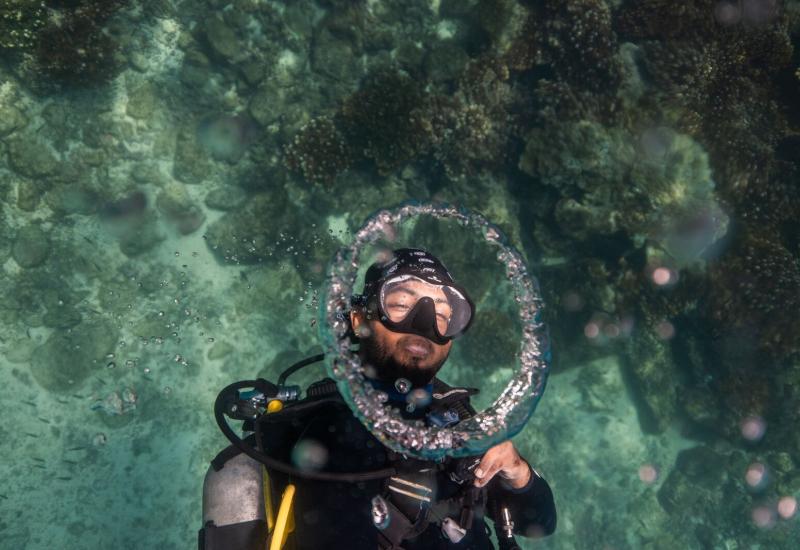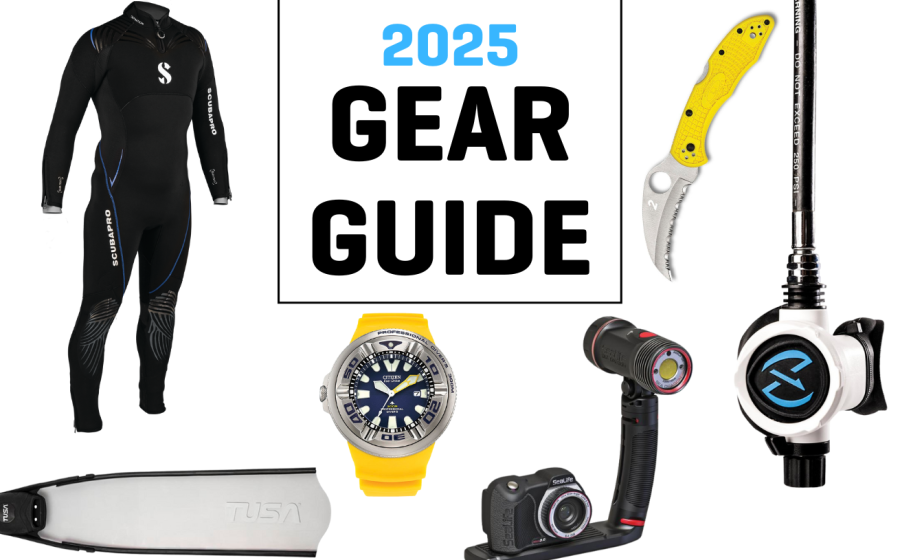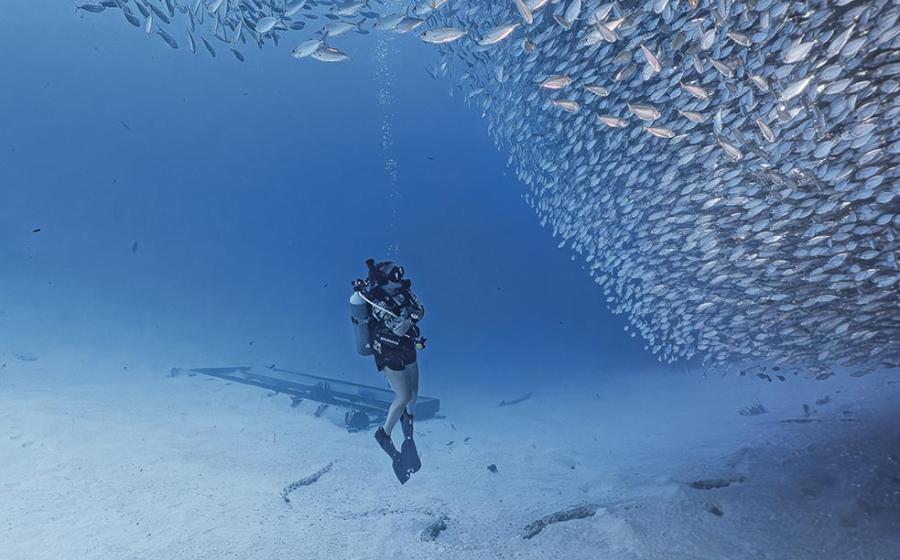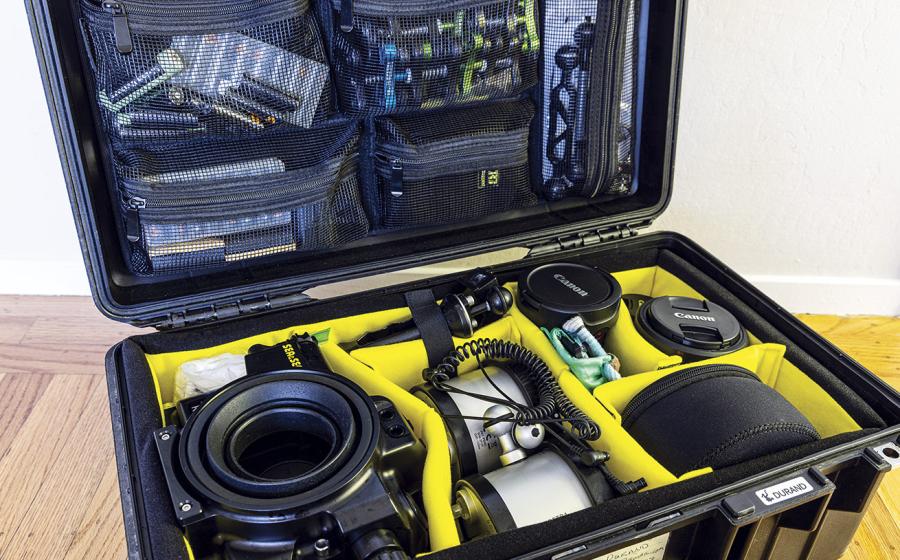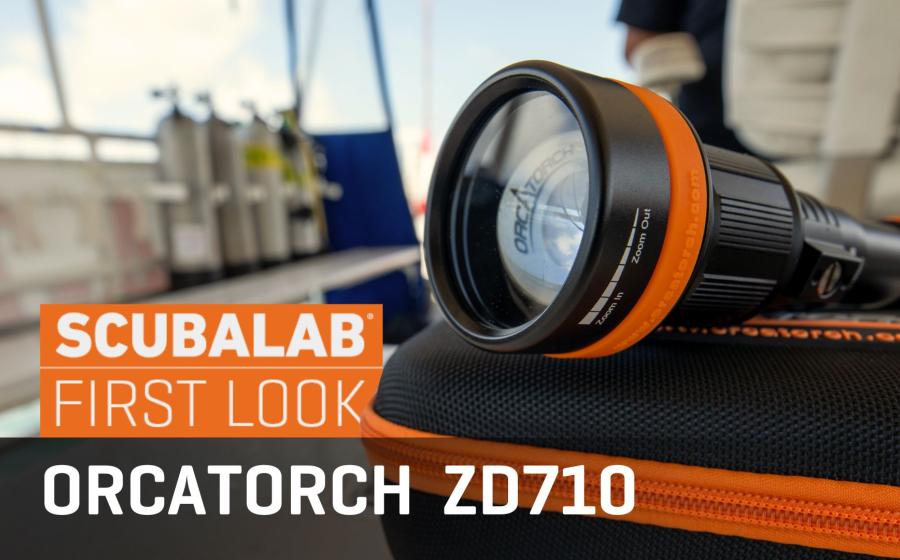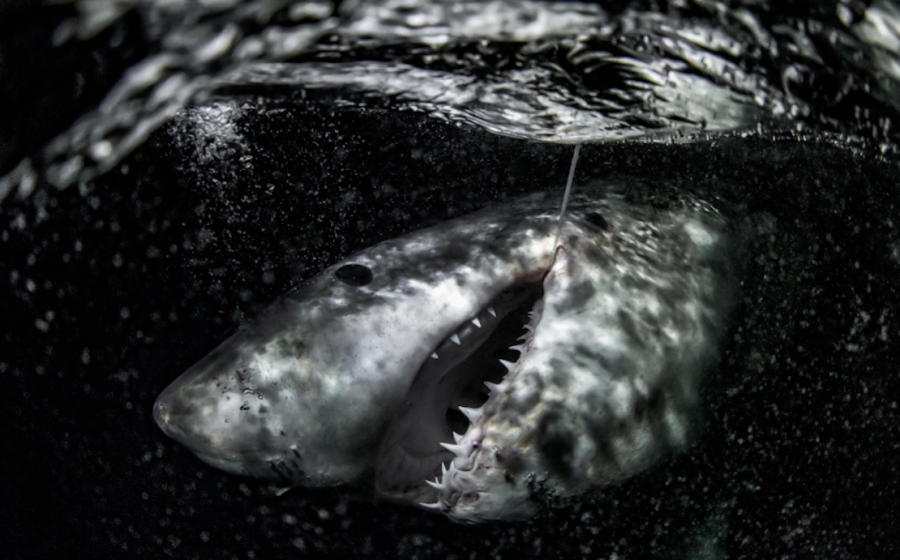Palm Beach, Fla.

Text and Photography by Tanya G. Burnett-Palmer
Our dive boat rolls in calm seas, about a mile offshore from the opulent island of Palm Beach and one of its most famous institutions, the historic Breakers Hotel and Resort. A short briefing prepares us for a dive on the north end of the two-mile-long Breakers Reef, a site named for the hotel. Moments later, I descend through 60 feet of warm water and a kaleidoscope of colors comes to life: blazing orange sponges, purple sea fans, plump gorgonians and robust barrel sponges. A gentle northbound current carries me along an undulating contour 10 to 15 feet above the sand. My senses are quickly overwhelmed by the staggering density of life here. Schooling grunts and snapper appear at every turn, angelfish swim by in a carnival of color, schools of Atlantic spadefish flash like liquid mercury in the sun, and shimmering clouds of copper sweepers and silversides flow in and out of holes. Undercuts create sanctuaries for nurse sharks and enormous loggerhead turtles.
It's a typical dive in the waters of the coastline around Palm Beach, Fla., where the diving is unique compared to the rest of the state. There are three parallel reef systems relatively close to shore, with inlets allowing easy access to the county's nearly 70 dive sites. Deep water close to land allows the Gulf Stream to flow closer to shore here than anywhere else on the U.S. East Coast, ensuring excellent water clarity and lots of healthy reef growth. More than 300 species of fish and hundreds of coral and sponge species are found in these waters. On every dive, you'll find teeming schools of fish and chance encounters with big pelagics. Almost every dive here is a drift dive, so you can cover maximum ground with minimal effort. Add a great selection of artificial reefs--including a shore dive at a bridge where the muck diving is compared to Indonesia's Lembeh Strait--and it's no wonder divers frequently return.
Juno Ledge
A few miles north of Palm Beach Inlet, a number of dive sites offer "wilderness diving" because of their relative lack of divers and rugged, pristine reefs. One of the best dives is Juno Ledge, about seven miles north of the Inlet, just east of the town of Juno Beach. When the water is as clear blue as a gemstone, you can see the reef 90 feet below. Like many other Palm Beach reefs, the ledge here actually faces west, but unlike most, Juno has up to 20 feet of vertical reef face. Juno also has mini canyons stacked with schooling grunts and snapper hiding from the current. Encounters with green, hawksbill and loggerhead turtles are possible, as well as enormous morays, schools of barracuda and reef sharks on patrol.
Shark Canyon
About 20 minutes north of Palm Beach Inlet, this is another great dive that delivers the unexpected. A parallel set of ledges running from 65 to 85 feet creates an unusual reef that attracts lots of action. The ledges are draped with soft coral flowing in the current, accented by sponges in lavender, burgundy and orange. In the midst of schooling tropicals, jacks and spadefish, a cavalcade of the big fellows also glides by. Eagle rays, nurse sharks, reef sharks, goliath grouper and schooling barracuda are all regulars. Turtles are almost a given on just about any Palm Beach dive, but at Shark Canyon extremely rare leatherback turtle encounters have been reported. On a good day, this dive ranks high on anyone's favorite Florida dives list.
The Mizpah, PC1170 and the Amaryllis
Most divers don't think of wreck dives as drifts, but exploring the Mizpah comes close. She's a 185-foot Greek luxury liner intentionally sunk in 1968 in 90 feet of water, making her a wonderfully mature artificial reef with a well-exposed interior that makes for easy penetration. Orange cup corals and gorgonians abound on her inner structure, while barracuda, jacks, southern rays and the occasional turtle patrol her exterior. Goliath groupers are common, though they can be shy.
The smaller PC1170 wreck is a patrol craft of unknown nationality that was also scuttled in the 1960s and rests in an area nearly touching the Mizpah's north side. If you follow the northbound current, you soon soar over enormous rock piles teeming with small tropical fish. Stopping here is tempting, but it's better to keep going until you see the 441-foot Amaryllis materialize. This hulking banana freighter, whose nationality is also unknown, sits in the sand at 85 feet and is devoid of superstructure. But she's one huge, open fishbowl where angelfish, wrasse and glassy sweepers carouse and every inch of metal supports life. If you're diving this wreck using nitrox, there's also time to check out another wreck, the China Barge, about 200 feet northwest of the Amaryllis, in about 80 feet of water. Her eight-foot-tall hull buzzes with life and her openings host huge spiny oysters.
Blue Heron Bridge
Just inside the Palm Beach/Lake Worth Inlet--and a stone's throw away from a parking lot--I make a shore dive in nine feet of water and encounter a frogfish, a rarity in these waters. It's far from its customary hiding habitat and is brazenly striding on its fins across the seafloor. In fact, it's one of the most unusual frogfish I've ever seen, sporting hairy-looking appendages and a striking pattern of chocolate brown stripes. This locally famous critter site, with diving done in the muck among the bridge's pilings, has been dubbed "the Lembeh Strait of Florida" by underwater photographers. After seeing a crazy array of other life, including nudibranchs, urchins and eight octopuses--I can see why. It would take several dives to see everything here.
Despite the great diversity of these Palm Beach dive sites, they barely scratch the surface of what this area provides, and ongoing research and exploration continue to uncover new sites. Locals and visitors who dive here year after year know that on any given day or dive, there's always a chance to see something incredible.
InDepth
Getting Around: Blue Heron Bridge is 20 minutes' driving from West Palm Beach International airport. Take Interstate 95 North to Blue Heron Boulevard, then go east to U.S. 1. Continue straight, over the bridge, then make a left into Phil Foster Park. For dive operators at marinas in Riviera Beach, follow U.S. 1 South from Blue Heron Boulevard. For Narcosis Dive Charters, go left at East 13th Street until reaching Riviera Beach Marina. For the Scuba Club, go left at 47th Street, then go right on North Flagler Drive. For Jim Abernethy's Scuba Adventures, go left on East 22nd Street to New Port Cove Marine Center.
Dive Conditions: Dive season is year-round, with water temps varying from the upper 60s in winter to the low 80s in summer, when visibility ranges from 40 to 100 feet.
Dive Outfitters and Charters: Narcosis Dive Charters (narcosisdivecharters.com), runs trips from Riviera Beach Marina, as does the Scuba Club (thescubaclub.com). Jim Abernethy's Scuba Adventures (scuba-adventures.com) is at New Port Cove Marine Center.

Text and Photography by Tanya G. Burnett-Palmer
Our dive boat rolls in calm seas, about a mile offshore from the opulent island of Palm Beach and one of its most famous institutions, the historic Breakers Hotel and Resort. A short briefing prepares us for a dive on the north end of the two-mile-long Breakers Reef, a site named for the hotel. Moments later, I descend through 60 feet of warm water and a kaleidoscope of colors comes to life: blazing orange sponges, purple sea fans, plump gorgonians and robust barrel sponges. A gentle northbound current carries me along an undulating contour 10 to 15 feet above the sand. My senses are quickly overwhelmed by the staggering density of life here. Schooling grunts and snapper appear at every turn, angelfish swim by in a carnival of color, schools of Atlantic spadefish flash like liquid mercury in the sun, and shimmering clouds of copper sweepers and silversides flow in and out of holes. Undercuts create sanctuaries for nurse sharks and enormous loggerhead turtles.
It's a typical dive in the waters of the coastline around Palm Beach, Fla., where the diving is unique compared to the rest of the state. There are three parallel reef systems relatively close to shore, with inlets allowing easy access to the county's nearly 70 dive sites. Deep water close to land allows the Gulf Stream to flow closer to shore here than anywhere else on the U.S. East Coast, ensuring excellent water clarity and lots of healthy reef growth. More than 300 species of fish and hundreds of coral and sponge species are found in these waters. On every dive, you'll find teeming schools of fish and chance encounters with big pelagics. Almost every dive here is a drift dive, so you can cover maximum ground with minimal effort. Add a great selection of artificial reefs--including a shore dive at a bridge where the muck diving is compared to Indonesia's Lembeh Strait--and it's no wonder divers frequently return.
Juno Ledge
A few miles north of Palm Beach Inlet, a number of dive sites offer "wilderness diving" because of their relative lack of divers and rugged, pristine reefs. One of the best dives is Juno Ledge, about seven miles north of the Inlet, just east of the town of Juno Beach. When the water is as clear blue as a gemstone, you can see the reef 90 feet below. Like many other Palm Beach reefs, the ledge here actually faces west, but unlike most, Juno has up to 20 feet of vertical reef face. Juno also has mini canyons stacked with schooling grunts and snapper hiding from the current. Encounters with green, hawksbill and loggerhead turtles are possible, as well as enormous morays, schools of barracuda and reef sharks on patrol.
Shark Canyon
About 20 minutes north of Palm Beach Inlet, this is another great dive that delivers the unexpected. A parallel set of ledges running from 65 to 85 feet creates an unusual reef that attracts lots of action. The ledges are draped with soft coral flowing in the current, accented by sponges in lavender, burgundy and orange. In the midst of schooling tropicals, jacks and spadefish, a cavalcade of the big fellows also glides by. Eagle rays, nurse sharks, reef sharks, goliath grouper and schooling barracuda are all regulars. Turtles are almost a given on just about any Palm Beach dive, but at Shark Canyon extremely rare leatherback turtle encounters have been reported. On a good day, this dive ranks high on anyone's favorite Florida dives list.
The Mizpah, PC1170 and the Amaryllis
Most divers don't think of wreck dives as drifts, but exploring the Mizpah comes close. She's a 185-foot Greek luxury liner intentionally sunk in 1968 in 90 feet of water, making her a wonderfully mature artificial reef with a well-exposed interior that makes for easy penetration. Orange cup corals and gorgonians abound on her inner structure, while barracuda, jacks, southern rays and the occasional turtle patrol her exterior. Goliath groupers are common, though they can be shy.
The smaller PC1170 wreck is a patrol craft of unknown nationality that was also scuttled in the 1960s and rests in an area nearly touching the Mizpah's north side. If you follow the northbound current, you soon soar over enormous rock piles teeming with small tropical fish. Stopping here is tempting, but it's better to keep going until you see the 441-foot Amaryllis materialize. This hulking banana freighter, whose nationality is also unknown, sits in the sand at 85 feet and is devoid of superstructure. But she's one huge, open fishbowl where angelfish, wrasse and glassy sweepers carouse and every inch of metal supports life. If you're diving this wreck using nitrox, there's also time to check out another wreck, the China Barge, about 200 feet northwest of the Amaryllis, in about 80 feet of water. Her eight-foot-tall hull buzzes with life and her openings host huge spiny oysters.
Blue Heron Bridge
Just inside the Palm Beach/Lake Worth Inlet--and a stone's throw away from a parking lot--I make a shore dive in nine feet of water and encounter a frogfish, a rarity in these waters. It's far from its customary hiding habitat and is brazenly striding on its fins across the seafloor. In fact, it's one of the most unusual frogfish I've ever seen, sporting hairy-looking appendages and a striking pattern of chocolate brown stripes. This locally famous critter site, with diving done in the muck among the bridge's pilings, has been dubbed "the Lembeh Strait of Florida" by underwater photographers. After seeing a crazy array of other life, including nudibranchs, urchins and eight octopuses--I can see why. It would take several dives to see everything here.
Despite the great diversity of these Palm Beach dive sites, they barely scratch the surface of what this area provides, and ongoing research and exploration continue to uncover new sites. Locals and visitors who dive here year after year know that on any given day or dive, there's always a chance to see something incredible.
InDepth
Getting Around: Blue Heron Bridge is 20 minutes' driving from West Palm Beach International airport. Take Interstate 95 North to Blue Heron Boulevard, then go east to U.S. 1. Continue straight, over the bridge, then make a left into Phil Foster Park. For dive operators at marinas in Riviera Beach, follow U.S. 1 South from Blue Heron Boulevard. For Narcosis Dive Charters, go left at East 13th Street until reaching Riviera Beach Marina. For the Scuba Club, go left at 47th Street, then go right on North Flagler Drive. For Jim Abernethy's Scuba Adventures, go left on East 22nd Street to New Port Cove Marine Center.
Dive Conditions: Dive season is year-round, with water temps varying from the upper 60s in winter to the low 80s in summer, when visibility ranges from 40 to 100 feet.
Dive Outfitters and Charters: Narcosis Dive Charters (narcosisdivecharters.com), runs trips from Riviera Beach Marina, as does the Scuba Club (thescubaclub.com). Jim Abernethy's Scuba Adventures (scuba-adventures.com) is at New Port Cove Marine Center.



